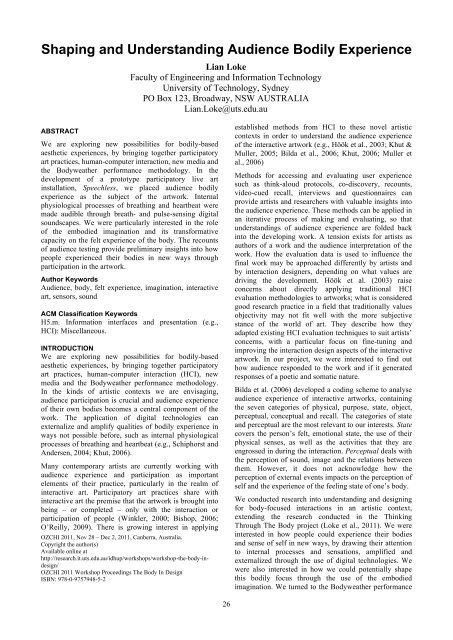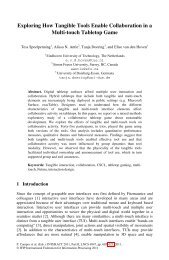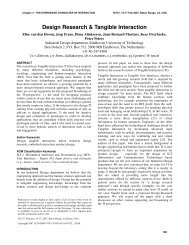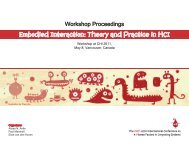Sissy - Elise van den Hoven
Sissy - Elise van den Hoven
Sissy - Elise van den Hoven
Create successful ePaper yourself
Turn your PDF publications into a flip-book with our unique Google optimized e-Paper software.
Shaping and Understanding Audience Bodily Experience<br />
ABSTRACT<br />
Lian Loke<br />
Faculty of Engineering and Information Technology<br />
University of Technology, Sydney<br />
PO Box 123, Broadway, NSW AUSTRALIA<br />
Lian.Loke@uts.edu.au<br />
We are exploring new possibilities for bodily-based<br />
aesthetic experiences, by bringing together participatory<br />
art practices, human-computer interaction, new media and<br />
the Bodyweather performance methodology. In the<br />
development of a prototype participatory live art<br />
installation, Speechless, we placed audience bodily<br />
experience as the subject of the artwork. Internal<br />
physiological processes of breathing and heartbeat were<br />
made audible through breath- and pulse-sensing digital<br />
soundscapes. We were particularly interested in the role<br />
of the embodied imagination and its transformative<br />
capacity on the felt experience of the body. The recounts<br />
of audience testing provide preliminary insights into how<br />
people experienced their bodies in new ways through<br />
participation in the artwork.<br />
Author Keywords<br />
Audience, body, felt experience, imagination, interactive<br />
art, sensors, sound<br />
ACM Classification Keywords<br />
H5.m. Information interfaces and presentation (e.g.,<br />
HCI): Miscellaneous.<br />
INTRODUCTION<br />
We are exploring new possibilities for bodily-based<br />
aesthetic experiences, by bringing together participatory<br />
art practices, human-computer interaction (HCI), new<br />
media and the Bodyweather performance methodology.<br />
In the kinds of artistic contexts we are envisaging,<br />
audience participation is crucial and audience experience<br />
of their own bodies becomes a central component of the<br />
work. The application of digital technologies can<br />
externalize and amplify qualities of bodily experience in<br />
ways not possible before, such as internal physiological<br />
processes of breathing and heartbeat (e.g., Schiphorst and<br />
Andersen, 2004; Khut, 2006).<br />
Many contemporary artists are currently working with<br />
audience experience and participation as important<br />
elements of their practice, particularly in the realm of<br />
interactive art. Participatory art practices share with<br />
interactive art the premise that the artwork is brought into<br />
being – or completed – only with the interaction or<br />
participation of people (Winkler, 2000; Bishop, 2006;<br />
O’Reilly, 2009). There is growing interest in applying<br />
OZCHI 2011, Nov 28 – Dec 2, 2011, Canberra, Australia.<br />
Copyright the author(s)<br />
Available online at<br />
http://research.it.uts.edu.au/idhup/workshops/workshop-the-body-indesign/<br />
OZCHI 2011 Workshop Proceedings The Body In Design<br />
ISBN: 978-0-9757948-5-2<br />
26<br />
established methods from HCI to these novel artistic<br />
contexts in order to understand the audience experience<br />
of the interactive artwork (e.g., Höök et al., 2003; Khut &<br />
Muller, 2005; Bilda et al., 2006; Khut, 2006; Muller et<br />
al., 2006)<br />
Methods for accessing and evaluating user experience<br />
such as think-aloud protocols, co-discovery, recounts,<br />
video-cued recall, interviews and questionnaires can<br />
provide artists and researchers with valuable insights into<br />
the audience experience. These methods can be applied in<br />
an iterative process of making and evaluating, so that<br />
understandings of audience experience are folded back<br />
into the developing work. A tension exists for artists as<br />
authors of a work and the audience interpretation of the<br />
work. How the evaluation data is used to influence the<br />
final work may be approached differently by artists and<br />
by interaction designers, depending on what values are<br />
driving the development. Höök et al. (2003) raise<br />
concerns about directly applying traditional HCI<br />
evaluation methodologies to artworks; what is considered<br />
good research practice in a field that traditionally values<br />
objectivity may not fit well with the more subjective<br />
stance of the world of art. They describe how they<br />
adapted existing HCI evaluation techniques to suit artists’<br />
concerns, with a particular focus on fine-tuning and<br />
improving the interaction design aspects of the interactive<br />
artwork. In our project, we were interested to find out<br />
how audience responded to the work and if it generated<br />
responses of a poetic and somatic nature.<br />
Bilda et al. (2006) developed a coding scheme to analyse<br />
audience experience of interactive artworks, containing<br />
the seven categories of physical, purpose, state, object,<br />
perceptual, conceptual and recall. The categories of state<br />
and perceptual are the most rele<strong>van</strong>t to our interests. State<br />
covers the person’s felt, emotional state, the use of their<br />
physical senses, as well as the activities that they are<br />
engrossed in during the interaction. Perceptual deals with<br />
the perception of sound, image and the relations between<br />
them. However, it does not acknowledge how the<br />
perception of external events impacts on the perception of<br />
self and the experience of the feeling state of one’s body.<br />
We conducted research into understanding and designing<br />
for body-focused interactions in an artistic context,<br />
extending the research conducted in the Thinking<br />
Through The Body project (Loke et al., 2011). We were<br />
interested in how people could experience their bodies<br />
and sense of self in new ways, by drawing their attention<br />
to internal processes and sensations, amplified and<br />
externalized through the use of digital technologies. We<br />
were also interested in how we could potentially shape<br />
this bodily focus through the use of the embodied<br />
imagination. We turned to the Bodyweather performance



![Download 1.8 MB [pdf] - Elise van den Hoven](https://img.yumpu.com/18078175/1/190x245/download-18-mb-pdf-elise-van-den-hoven.jpg?quality=85)

![Download 0.2 MB [pdf] - Elise van den Hoven](https://img.yumpu.com/18078145/1/182x260/download-02-mb-pdf-elise-van-den-hoven.jpg?quality=85)
![Download 0.1 MB [pdf] - Elise van den Hoven](https://img.yumpu.com/18078125/1/190x146/download-01-mb-pdf-elise-van-den-hoven.jpg?quality=85)
![Download 1.9 MB [pdf] - Elise van den Hoven](https://img.yumpu.com/18078041/1/182x260/download-19-mb-pdf-elise-van-den-hoven.jpg?quality=85)

